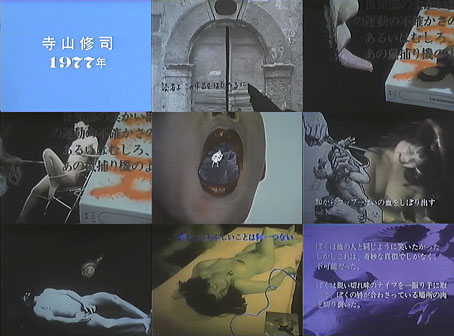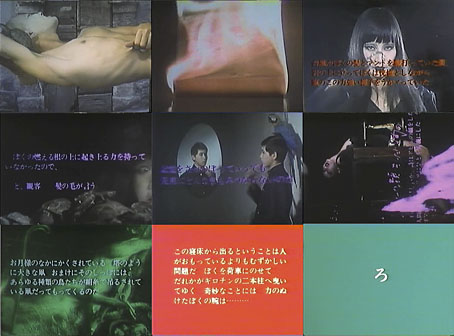
27 minutes of experimental video from 1977 in which director Shuji Terayama retrieves some predictably unorthodox images from the bottomless pit of Lautréamont’s text. The preoccupations here seem to belong as much to the director’s mind as to that of Isidore Ducasse, what with the emphasis on various forms of bondage and unusual erotics. (Not that Maldoror lacks sexual material but what there is adopts a different guise.) With a score that sounds like outtakes from a Clock DVA studio session it’s very much a product of its time, but not without interest. Terayama was (among other things) the director of Emperor Tomato Ketchup (1971), a film whose title was later swiped by Stereolab. Les Chants de Maldoror may be viewed at Ubuweb.

Previously on { feuilleton }
• Polypodes
• Ulysses versus Maldoror
• Maldoror
• Books of blood
• Magritte’s Maldoror
• Frans De Geetere’s illustrated Maldoror
• Maldoror illustrated

Because he was seen as darkly surreal and transgressive, Lautréamont is often mentioned in the same category as William S Burroughs and his brethren. The fact that various musicians and underground filmmakers draw influence from Maldoror in similar manner to projects based around Burroughs’s body of work, makes this seem all the more strangely coincidental. Had Burroughs or any of his friends, perhaps Gysin, ever made reference to Lautréamont as an influence, that you’ve heard of?”
That’s a good point. I don’t think I have ever seen a mention of Lautréamont from either of them, even though their years in Paris would have made Maldoror hard to miss. Burroughs was more concerned with Rimbaud who he saw as a kind of Wild Boy poet figure: taking drugs, having sex with men, later running guns in Africa. However, you’d think Burroughs would at least be interested in Maldoror since the text often seems to collage material from different sources. In that respect it’s far in advance of anything else, Rimbaud included.
Jeremy Reed wrote a novel, Isidore, about Lautréamont, pitching him as yet another Wild Boy type. That’s easy to do since so little is known of Isidore Ducasse’s life:
http://www.goodreads.com/book/show/679742.Isidore
I am not sure how you feel about the Japanese style of animation. On one hand a lot of the incredibly derivative and kitschy crap out there is just as incredibly popular and over-publicized. On the other, there are quite a few hidden gems in rough as the phrase goes. One of my favorite series, Shigurui Death Frenzy, is ‘not’ surrealist per se, and though it plays plenty of tricks with multiple viewpoints and traditional frames of times albeit never in a gimmicky manner, its storyline is relatively linear in nature.
This being said, and as is the case with books and movies like Dune for instance, much of the storyline transpires within the characters’ minds, most of whom are fairly imbalanced, indeed the most frightening of the characters seem to be the most balanced. This approach is often performed in an almost stream-of-consciousness fashion wherein fragments of one person or another’s fevered mind color and embellish world they see around them. When the world around them grows ever more violent and treacherous, what the narrators’ see becomes almost rapturously surreal and perverse and almost visionary at times.
Another long hypothesis-made-short. If anyone else from the Land of the Rising Sun wants an interpretive go at Maldoror, the people behind Shigurui ought to give it a look.
These are what I could find, the episodes grow more surreal as the series bares on.
http://vimeo.com/46018806
http://vimeo.com/45984796
As for what you said, what I’ve read of Jeremy Reed, the Pleasure Chateau Omnibus, has been very impressive indeed. At some point I’d like to read Dorian as well. Its easy to see why Ballard liked him so much.
Thanks, I like Akira a great deal although I know that’s in a different league to many cheap anime things. I’ll download those to watch later, Vimeo always stutters when I’m trying to watch it live.
I’ve grown a little impatient in the past with Japanese things that always end up with two guys fighting each other for a very long time; I’m aware it’s as much of a convention as two gunfighters facing off but all the same…occasionally you want something different. Akira ends like that, as does Casshern and the Tetsuo films, all of which I enjoyed otherwise.
There ‘is’ a long-standing feud at the center of Shigurui, but its much more subtle in this case, with several lesser feuds branching from it, and comes most often in the form of unforeseen manipulation and near-fatal assassination attempts, which would not be expected because, as I’ve said, this is definitely one of the more violent and surreal anime series. Birth Cry is probably my favorite episode, though I couldn’t find it anywhere besides youtube. Should you decide to keep watching on the strength of the first few episodes, well, as the series continues you’ll see a lot of recurring eye candy given your predilection for anatomy, exoskeletons, and lunar/celestial imagery, at least I would think. There is indeed some brief homoeroticism present throughout, though it could hardly be said to be of a positive nature. I would not worry a great deal though, because ‘none’ of the eroticism present throughout is of a positive or terribly romantic nature.